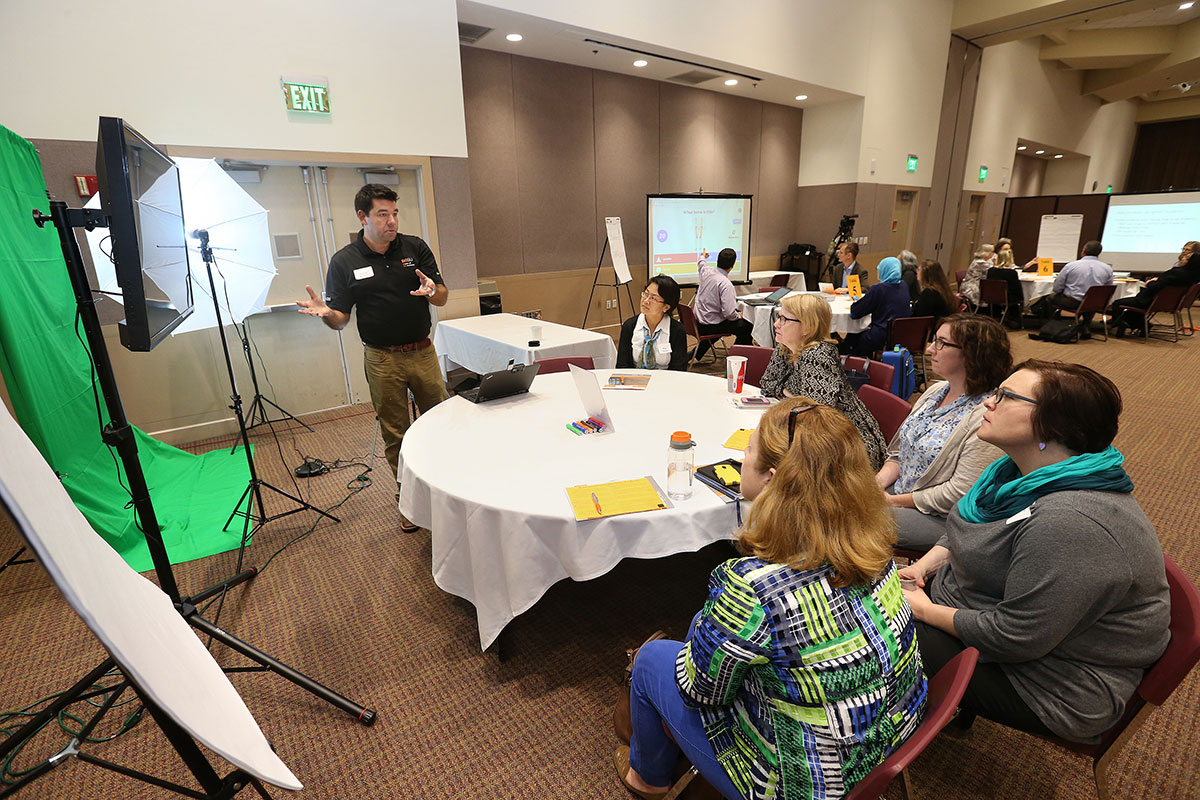Creating ‘content contributors, not content containers’

“Meeting time is sacred time. Class should be spent doing only the things that can only be done when those people are together in that classroom,” said Erin Hachtel, a student in the executive master of organization development program.
Hachtel was a student panelist at the recent “Demystifying the Flipped Classroom” Teaching Summit hosted by the College of Business Administration. She affirmed the belief of keynote speaker Dr. Jose Bowen, president of Goucher College and a leading expert in flipped learning. Bowen is also the author of “Teaching Naked,” which refers to faculty being totally present for their students in class, designating listening and reading assignments to time out of class and active problem-solving to in-class time.
About 100 people participated in the summit, including BGSU faculty from across colleges and disciplines, faculty from other universities, business people and even people watching by live stream from as far away as Nigeria.
In addition to talking together, participants also shared with colleagues by tweeting throughout the event.
The summit began with an intensive session led by Bowen for faculty who already had experience in the “flipped” classroom. Others had not yet tried it but were intrigued and wanted to learn more. In the second part of the day, participants heard from BGSU faculty who have experience in the innovative style of teaching and learning.
“There was a positive, energized vibe in the room all day as people were listening and sharing,” said summit organizer Dr. Steven Cady, management, who facilitated the day’s activities. “This was a group of hopeful, enthusiastic and creative faculty and professionals.”
“I’ve done a lot with flipping already,” said Carrie Hamady, food and nutrition. “I wanted to learn how to make it better. Jose Bowen was just a great speaker. He validated some things I’d already been doing and also gave some very useful, practical tips.”
“Flipped’ learning is kind of like lasagna, observed Cady. There are layers, and each can be improved and can hold some surprises.
Attendees learned about developing their flipped teaching “recipes” for getting students more involved in their own educational process, or, as Bowen said, making them “content contributors, not content containers.”
Bowen spoke of creating a “pleasantly frustrating zone for learning,” as with a challenging game, to more fully engage students with the material.
Student panelist Josh Main, a master of accountancy student, said he benefited from being able to watch online lectures as many times as necessary, which then enabled him to ask more deep, thoughtful questions.
Student panelists and faculty practitioners agreed accountability is a key component of active learning. To work successfully in groups, students need to “find their voice,” as Hamady said. Sometimes the online portion of class can help more introverted students become comfortable speaking up.
“When you’re in an internship or in your job, you can’t hide anymore,” she said.
This, Cady noted, is where the “meta” level of learning takes place — while learning the content, they are also learning to be leaders and collaborators.
The classroom is the place to build confidence in their learning skills, where it’s OK to experiment and to fail, gaining confidence along the way. The educator must provide a defined structure within which students can “play and experiment,” Cady said.
“You really begin to realize how important the pedagogy and the classroom environment are to their professional development,” he said. “We are educating the leaders of the future.”
Cady noted that the layers of flipped learning include the top: taking the content out of the classroom and serving it up to the students in a way that they can engage with, then assessing them so that when they come to class “you already know if they got it, and you can give a deeper focus on their areas of need.”
The second layer is improving the outside-of-class content and adaptive learning assessments so you can go deeper in class. Bowen spoke of developing more evaluative types of questions to stimulate critical thinking, for example.
The third layer is continually improving classroom activities, Cady said, to “keep engaging students creatively and provoking them to be involved in their own learning.”
Participant Dr. Catherine Cassara, School of Media and Communication, has used a hybrid of flipped and traditional classroom practices. She said that, although it may take longer for students to find information themselves and be more active in creating content, “it’s deeper learning and you have to trust it.”
Updated: 05/30/2019 01:01PM
